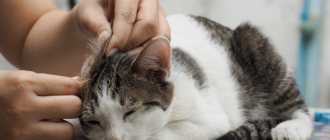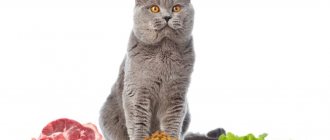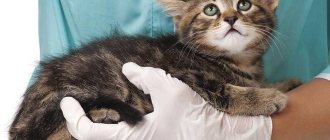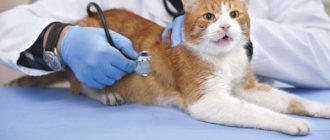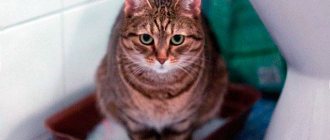Symptoms of urolithiasis in a cat
The most common cause of urolithiasis is poor diet. Low-quality dry food and canned food do not contain enough vitamins and microelements, which entails negative changes in the animal’s metabolism.
You should be wary if:
- the cat became less active and sad
- The cat has a decrease in appetite
- the cat comes to the litter box several times
- cat acts restless when peeing
- The cat can't urinate the first time
The listed signs are the first symptoms of urolithiasis. If the cat begins to sit in the litter box for a long time, goes to the toilet more often, screams when urinating, or the urine becomes bloody - these are more serious symptoms in which you should immediately consult a veterinarian.
Treatment of urolithiasis in cats in Rostov-on-Don
Treatment of urolithiasis in cats should begin with making an accurate diagnosis and determining the stage of the disease. The veterinarian will take all the tests, do an ultrasound if necessary and prescribe treatment. To do this, it is not necessary to take your pet to a veterinary clinic; the veterinarian will come to your home, conduct an examination and prescribe treatment.
Urolithiasis can be treated at home, but only in accordance with the recommendations of a veterinarian. He will prescribe medications for treatment and also write a diet for the cat.
Nutrition is of particular importance in treatment. Therefore, you should strictly adhere to the veterinarian's recommendations.
In some cases, surgery may be required. A cat is operated on if: its urethra is blocked, the stones are large and cannot pass naturally, the stones are oxalate and insoluble.
Do not try to treat urolithiasis in cats yourself. This is a serious disease that threatens the life of the animal! If you notice the first symptoms of urolithiasis, you should immediately contact a veterinarian.
Still have questions? You can get a free consultation by phone
Urine excretion is a natural process for cats, as for other mammals. When urinating, the animal gets rid of excess fluid, unnecessary and harmful substances and food processing products. A disruption in the process of urine excretion most often indicates the occurrence of a pathological condition of the genitourinary system. Why does my cat urinate frequently?
How to help your pet?
To determine treatment tactics, a specialist conducts an examination and prescribes urine and blood tests. In some cases, an ultrasound of internal organs is performed. Typically, therapy is as follows:
- taking antibacterial drugs;
- use of painkillers in the presence of pain;
- consumption of vitamins and minerals;
- prescribing medications to relieve inflammation.
If a cat has kidney stones, surgery may be prescribed. To normalize the pet’s condition, a special diet is developed that excludes foods that provoke pathology. During treatment, the animal must be isolated from communication with other pets.
The group was created with the purpose of finding and adopting animals. If you have lost someone, or found someone, or simply want to adopt or rescue an animal, you can do it here
If you want to adopt a cat or a kitten, or a dog, you can save someone’s life from the state shelter at the address: Portovaya street, 1/7, Rostov-on-Don, Russia, open daily from 9 to 17 hours from 13 to 14 break , tel. 238-25-24 also at this address free sterilization of cats, cats and dogs will be carried out, call for any questions about sterilization
How often can a kitten or adult pet urinate and how much?
The volume of urine produced and the number of daily urinations of a cat depend on several factors:
- Age. A kitten up to 3 months old can relieve itself once a day. This is due to the peculiarities of its nutrition. At an early age, cats consume mainly mother's milk, which is almost completely absorbed by the body. Kittens aged 3–6 months urinate 3 times a day. A six-month-old pet goes to the toilet in small increments up to 6 times. Adult cats go to the toilet 3-5 times a day.
- Floor. Males and females have different structures of the genitourinary system. A male cat tends to pee more often than a male cat.
- Physical activity. An active animal drinks more often, so the cat pees often. If the pet is motionless for most of the day, it can urinate once a day.
- Amount of fluid consumed. In hot weather, a cat may drink a lot of water, which leads to frequent urination.
Recommendations
How to get a kitten to go to the toilet? After feeding, carefully and at the same time firmly fix the pet so that it cannot slip out. The fingers of the hand should be located simultaneously under the chest and stomach, so that the tail is towards the caregiver. You need to put a damp, warm napkin on your other hand, preferably white, but you can also use light colors, because it’s easier to tell on a light fabric whether the kitten went to the toilet or not.
Next, you need to stimulate the baby to urinate. Do not apply strong pressure and wipe the area from the lower abdomen to the anus. If the kitten went to the toilet (did not defecate - wiping continues), then you need to move to the anal area, doing a specific massage. Usually the effect occurs within a minute. But it happens that animals cannot go even after several feedings. Then you need to show him to a veterinarian.
After the job is done, you must first wipe the contaminated areas of the skin with a clean edge of the napkin (urine and feces are irritating, and dermatitis or a genitourinary tract infection may develop at the site of their appearance, since there is no strong immunity yet formed). It is also necessary to dry wet areas. This procedure is done for each kitten.
If there are several children, separate napkins are allocated for each of them (these can be pieces of bandage, gauze, cotton pads, which are thrown away after use). The whole procedure must take place in a warm room without drafts, otherwise the baby will become hypothermic and die.
What should you be wary of?
A healthy cat does not feel discomfort when urinating. Urine comes out quickly, so the animal spends little time in the tray. As urine is released, a characteristic murmur can be heard. If your pet goes to the toilet more often than usual, but at the same time empties quickly and does not show anxiety, you should pay attention to how much water he drinks and what color his urine is.
When your urine is yellow or orange and your high fluid intake is caused by hot weather, there is no need to worry. Sometimes the urge to urinate becomes more frequent in aging cats. As the animal grows older, the urinary sphincter muscles become weaker, and the animal goes to the toilet more often. The following manifestations should alert you:
- during urination the pet meows;
- the animal is restless or lethargic;
- urine has an unusual color or unpleasant odor;
- the number of urinations has increased in a young pet for no apparent reason;
- The cat pees often and drop by drop.
Causes of frequent urination and decreased urine volume
Problems with urination in a cat cannot be ignored. An animal can pee often and little by little due to various diseases, which, if left untreated, lead to a worsening of the condition and death of the animal. Most often, diseases occur in adult pets. However, kittens are also sometimes found to have pathologies that cause urinary problems. In some cases, the problem has a physiological cause.
The cat has cystitis
Cystitis is the most common disease of the genitourinary system in animals. With this pathology, the mucous membrane of the bladder becomes inflamed, which leads to impaired urinary function. This disease takes a long time to develop and does not manifest itself in the initial stage. Acute cystitis can become chronic. Main symptoms:
- the animal defecates frequently;
- urine is excreted in small portions;
- the process causes pain to the pet, which is noticeable by meowing before and during urination;
- the cat began to constantly lick the crotch;
- stomach is hard;
- sometimes the animal sits on the tray for a long time, but cannot squeeze out even a drop;
- frequent vomiting;
- increased thirst;
- dark colored urine;
- The discharge has a strong ammonia smell.
Stress and strong emotional tension
Cats are susceptible to stress caused by fear, excitement, jealousy, changes in their usual daily routine, trips to the veterinarian, or moving to a new place of residence. A strong emotional shock can cause unwanted behavior in an animal, in which it forgets its “toilet” skills and begins to shit anywhere, even on the owner’s bed. This is how the cat expresses its emotions and calls on its owner for help. It is impossible to strongly scold or physically punish a pet for this offense; on the contrary, you need to show maximum attention to it. We recommend showing more affection, care and communication to the animal in anticipation of possible stressful situations, which include:
- change of place of residence;
- traveling by car or public transport;
- journey;
- arrival of guests;
- the appearance of a small child in the house;
- the appearance of another pet, etc.
If a puddle on the bed is caused by a stressful situation, it is important to prevent the animal’s unwanted behavior from becoming established.
Why does blood appear in urine?
The appearance of blood in the urine, or hematuria, is an alarming symptom indicating the development of a serious pathology. Blood appears in urine due to various reasons:
- Injury. With a strong blow, damage to internal organs and blood vessels can occur, and blood begins to penetrate into the bladder.
- Urolithiasis disease. When stones and sand leave the kidneys, the walls of the urinary tract are damaged. This condition is often aggravated by the addition of an infection.
- Cystitis. Blood appears when the pathology is advanced.
- Long-term use of potent drugs. If blood clots appear, you must stop taking the drug and contact your veterinarian to adjust the therapy.
- Blockage of the urinary canal. The pathology occurs as a result of a long-term inflammatory process in the urethra.
- Malignant neoplasm. Most often observed in cats in adulthood.
Necessary treatment
Taking into account all the symptoms and based on the examination, the veterinarian prescribes special treatment.
If a cat develops blood after castration or a pregnant cat suffers from bloody impurities in the blood, then it is necessary to urgently contact a veterinarian to determine the source of the pathology. Treatment of the animal is required depending on why it is peeing blood and taking into account additional symptoms. The table shows different treatment methods.
| Deviation | Therapeutic measures |
| Diseases of inflammatory nature | If your pet has peed bloody urine once, the veterinarian will prescribe anti-inflammatory, antispasmodic and painkillers. |
| Advanced diseases | Taking oral or intramuscular antibiotics |
| Using vitamin complexes and herbal decoctions to strengthen the immune system | |
| Internal bleeding | Using medication to stop bleeding |
| Urolithiasis | If the cat pees with blood and little, then this indicates stones in the urinary system, which can be removed with medications and nutritional correction. |
| If there is difficulty urinating, urine is removed using a catheter | |
| In advanced cases, surgery is possible | |
| Dehydration | Injection of glucose and saline solutions into a vein |
| Some types of poisoning | Vitamin K1 intake |
